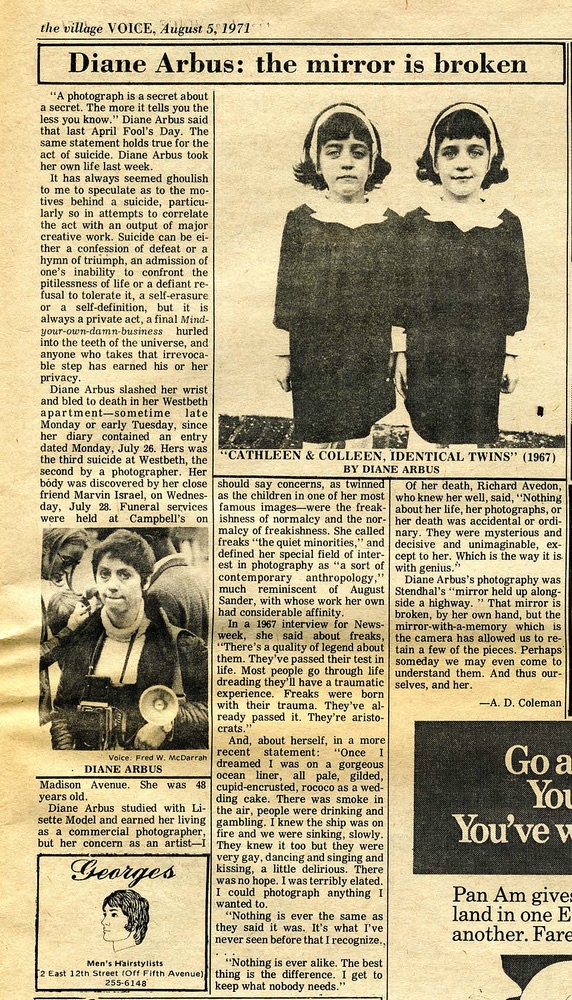 [Currently a swirl of activity commemorates the 1972 Diane Arbus retrospective at the Museum of Modern Art in New York and the accompanying monograph, published by Aperture. For the original Museum of Modern Art press release on the Arbus retrospective and monograph, click here. For “A New Look at a Diane Arbus Exhibition, 50 Years Later,” M. H. Miller’s report on the David Zwirner Gallery’s recreation thereof, published in the New York Times on September 14, 2022, click here.
[Currently a swirl of activity commemorates the 1972 Diane Arbus retrospective at the Museum of Modern Art in New York and the accompanying monograph, published by Aperture. For the original Museum of Modern Art press release on the Arbus retrospective and monograph, click here. For “A New Look at a Diane Arbus Exhibition, 50 Years Later,” M. H. Miller’s report on the David Zwirner Gallery’s recreation thereof, published in the New York Times on September 14, 2022, click here.
In 1971 I wrote a short obituary for/tribute to Diane Arbus for the Village Voice, published on August 5 not in my column but as a stand-alone article. You’ll find it reproduced below.
A year later I reviewed the retrospective in my column at the New York Times. It appeared on November 5, 1972, almost exactly 50 years ago. The text of that article follows the obit. I included both of these essays in my 1979 collection, Light Readings.
Both of them now also appear in a new book, Diane Arbus: Documents, published in conjunction with the present reconsideration of that 1972 show and book and their impact. I’ll have more to say about that publishing project in an upcoming post.— A.D.C.]
•
Diane Arbus: the mirror is broken (1971)

A. D. Coleman, Diane Arbus Obituary, Village Voice, 8-5-71
•
Diane Arbus: Her Portraits are Self-Portraits
In some few rare cases a body of creative work is not primarily a statement of esthetic sensibility or an intellectual feat of strength or a sermon or anything abstractable and removed, but rather the naked manifestation of the artist’s moral code in action.
There are ethical decisions involved in all forms of creative work, of course, but they are perhaps closest to the surface in still photography. A photographic image is a transformation of reality; when selected with consciousness and an intention beyond the recording of surface, it is inevitably a remaking of an event into the photographer’s own image, and thus an assumption of godhead.

Diane Arbus monograph (1972), cover
The ethical issues inherent in the photographic medium are most fully exposed in the act of portraiture, by which I am referring specifically to portraits of other people. (It is, of course, possible to make a portrait of a tree — another life form — or even of a rock; it is also possible to exploit these two nonhuman subjects, and all others as well. But that is another discussion, and less pertinent to ourselves.) There are no hard and fast rules for ethical portraiture. Most photographers, no matter what their subject, take photographs; a few, to use Minor White’s distinction, make photographs; fewer still (as Robert Leverant puts it) give photographs.
Diane Arbus gave portraits — an astonishing number of them, as can be seen in the retrospective exhibit opening on Nov. 7 at the Museum of Modern Art, and in the accompanying monograph on her work. She was able to do so by virtue of her absolute and intransigent insistence on documenting what I can only term the truth concerning an interaction which demanded her own self-revelation as the price for the self-revelation of her subject. This process is by necessity intuitive, for it cannot be systematized, dependent as it is on the constantly fluctuating state of one’s finally secret soul.
John Szarkowski, who directed the retrospective, indicates that her work “challenged the basic assumptions on which most documentary photography of the period had been predicated” by being “concerned primarily with psychological rather than visual coherence, with private rather than social realities, with the prototypical and mythic rather than the topical and temporal. Her true subject was no less than the interior life of those she photographed.” And, he might have added, of herself as well, for her portraits are self-portraits as well.
She gravitated to subjects we group under the label of “freaks” — midgets, giants, hermaphrodites, twins, lesbians — not out of any decadent search for the outré but because she saw them as heroes who had already passed their individual trials by fire while most people stood around pleading for theirs to be postponed. It is not surprising that her work was often misunderstood — though that should be more infrequent now that a large body it, most of which has never been shown before, is readily available — nor that it had its greatest impact on a generation which followed Bob Dylan to the same territory.
Without disagreeing with the impeccable distinctions made by John Szarkowski in the statement quoted above, I would like to point to one specific area of current cultural consciousness and change to which her work is particularly relevant, prophetically though not intentionally so. Like the German photographer August Sander — to whom her work is linked but not beholden — Arbus explored her subjects’ roles. But where Sander concerned himself principally with the roles imposed by class and occupation, Arbus dealt with those imposed by body and gender.
 As Marvin Israel has commented, she made no nudes, “only pictures of naked people.” They are all freaks — as are we all, equal in our differentness. Some happen to be physically abnormal while others are more average, some happen to be male and some female. Her images are never concerned with how these individuals appear, only with their relationship to their physical and sexual selves — what they’ve done with what they were given. Look at such images as “Hermaphrodite and dog,” “Girl sitting on her bed with her shirt off,” “Woman with veil on Fifth Avenue, “Two friends at home,” and “A naked man being a woman” — especially the last one …
As Marvin Israel has commented, she made no nudes, “only pictures of naked people.” They are all freaks — as are we all, equal in our differentness. Some happen to be physically abnormal while others are more average, some happen to be male and some female. Her images are never concerned with how these individuals appear, only with their relationship to their physical and sexual selves — what they’ve done with what they were given. Look at such images as “Hermaphrodite and dog,” “Girl sitting on her bed with her shirt off,” “Woman with veil on Fifth Avenue, “Two friends at home,” and “A naked man being a woman” — especially the last one …
There is more, much more, to talk about; her humor, for example, and her tenderness — in which regard the untitled series made in a home for the retarded merits a lengthy discussion all to itself. There is time for analysis later; right now while it is still fresh and uncategorized is our last opportunity to stand before her work and try to match its nakedness.
Let us not permit ourselves to assume — pretty as it may be to think so — that when she committed suicide over a year ago she had no idea of how important her work already was to so many and would become to so many more. Consider instead the possibility that she did know — and that such knowledge was not enough. Diane Arbus once said, “… somebody else’s tragedy is not the same as your own.” Janis Joplin once said, “I’m going to write a song about making love to 25,000 people in a concert and then going back to my room alone.”
•
[Note: Robert Leverant (1939-2021), cited above, was a Bay Area-based photographer and thoughtful writer on the spiritual/metaphysical aspects of the medium. His books include Zen In the Art of Photography (1969), On the transmission of photography (1972), and Photographic notations (1980). We corresponded, briefly, and met and talked on several occasions. Click here for an obituary. — A.D.C.]
•

Special offer: If you want me to either continue pursuing a particular subject or give you a break and (for one post) write on a topic — my choice — other than the current main story, make a donation of $50 via the PayPal widget below, indicating your preference in a note accompanying your donation. I’ll credit you as that new post’s sponsor, and link to a website of your choosing.
And, as a bonus, I’ll send you a signed copy of my new book, poetic license / poetic justice — published under my full name, Allan Douglass Coleman, which I use for my creative writing.





Leave a Comment